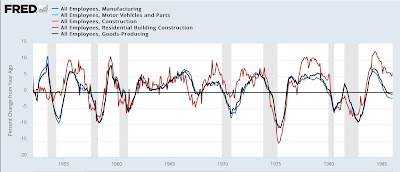- by New Deal democrat
On Monday I wrote that the Household survey portion of the jobs report was recessionary for the second time in three months. But I pointed out that there was a very large divergence in jobs growth in the past 24 months, amounting to 1.7% of the prime age workforce, between that survey and the Establishment survey, one of the largest such divergences on record.
Today let’s take a look at the Establishment survey, which is much more positive.
Every month as part of my look at the jobs report, I look at the leading employment sectors. These are the ones that usually turn down first before the overall jobs market does.
So let’s look at five of those sectors: manufacturing, the sub-sector of motor vehicle manufacturing, construction, the sub-sector of residential building construction, and goods production as a whole.
To begin with, with the exception of the manufacturing data in several months, almost all of these have been positive every month for the entire last year:
That’s pretty positive, especially when we see how this compares with the historical record.
Here’s the YoY% change in each post-pandemic:
Unsurprisingly, per the above, all are positive.
Here is the historical record:
With the exception of 1960 and the two oil shocks of the 1970s, all or at least most of these had turned negative before or just as the recession was beginning. That’s not the case now.
Even before these average hours in manufacturing have turned down, typically by more than -.5 hours YoY. At present, average manufacturing hours are down -0.1:
Here’s the historical record for comparison:
Especially in the past 30 years, there have been about half a dozen times when manufacturing hours have been down more than they are now YoY without a recession occurring.
In short, when we look at the jobs sectors that we would expect to already be suffering before a recession were to start, there are no such signs of distress at present. And since the Establishment Survey is bigger and less noisy than the Household Survey, we should expect the divergence between the two to resolve in the Establishment Survey’s direction.






